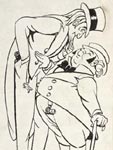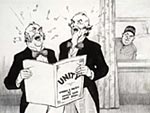
INTRODUCTION
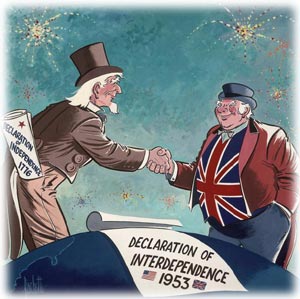 As
personifications of their respective nations, Uncle Sam and John Bull
became popular during the nineteenth century. John Bull originated
earlier, as a character in John Arbuthnot's The History of John
Bull (1712). He became widely known from cartoons by Sir John
Tenniel published in the British humor magazine Punch during
the middle and late nineteenth century. In those cartoons, he was portrayed
as an honest, solid, farmer figure, often in a Union Jack waistcoat,
and accompanied by a bulldog. He became so familiar that his name frequently
appeared in books, plays, periodical titles, and as a brand name or
trademark. Although frequently used through World War II, since the
1950s John Bull has been seen less often. As
personifications of their respective nations, Uncle Sam and John Bull
became popular during the nineteenth century. John Bull originated
earlier, as a character in John Arbuthnot's The History of John
Bull (1712). He became widely known from cartoons by Sir John
Tenniel published in the British humor magazine Punch during
the middle and late nineteenth century. In those cartoons, he was portrayed
as an honest, solid, farmer figure, often in a Union Jack waistcoat,
and accompanied by a bulldog. He became so familiar that his name frequently
appeared in books, plays, periodical titles, and as a brand name or
trademark. Although frequently used through World War II, since the
1950s John Bull has been seen less often.
Uncle Sam originated in popular
culture. His origins are disputed, but the name usually is associated
with Sam Wilson, a businessman who supplied the army during the War
of 1812. His barrels were stamped "U.S." for the government, leading
him to be nicknamed "Uncle Sam." The symbolic Uncle Sam's appearance
evolved from that of Brother Jonathan, the most common earlier symbol
for the United States. The two characters were used interchangeably
from the 1830s through the 1860s.
As with John Bull, the cartoonists
of Punch helped develop the figure, showing him as a lean,
whiskered man wearing a top hat and striped pants. The famous American
cartoonist Thomas Nast crystallized the image with his cartoons beginning
in the 1870s. By 1917, when James Montgomery Flagg depicted him on
the famous World War I recruiting poster, Uncle Sam was an icon, readily
recognized around the globe. He was officially adopted as the national
symbol of the United States in 1950.
John Bull and Uncle Sam have
often been depicted interacting, as friends or antagonists, and thus
their names were selected as appropriate symbols for this exhibition.
This introductory section provides a small sampling of images of the
two characters from the last hundred years. Other images will be found
in additional sections of the exhibition.
|
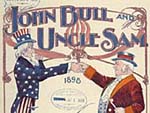 William
Allan and J.B. Herbert. William
Allan and J.B. Herbert.
John Bull and
Uncle Sam.
Chicago:
S. Brainard's Sons, [1898].
Sheet music cover.
Music Division, Library
of Congress (75A)
|
Song Celebrates British-American Ties
This song written by a member of the
British Parliament celebrates the peaceful resolution
of the Venezuela Boundary Dispute in 1898--the last time
the United States and Britain came close to going to
war. |
|
John Bull Recruiting Poster
This World War I military recruiting
poster demonstrates that more than a century after independence
from Great Britain, in many areas the United States still
copied the mother country. This British recruiting poster
showing John Bull was produced in 1914 or 1915, before
mandatory conscription began. Both this and James Montgomery
Flagg's Uncle Sam poster (77) are similar to an earlier
recruiting poster showing Britain's Lord Kitchner.
|
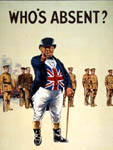 "Who's
Absent? "Who's
Absent?
Is It You?"
ca. 1916.
Courtesy of the
Imperial War Museum, London (77A)
|
|
|
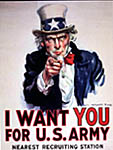 James James
Montgomery Flagg.
"I Want You For
the U.S. Army."
New York: Leslie-Judge Co., 1917.
Color Lithograph.
Prints and Photographs
Division, Library of Congress (77)
|
Uncle Sam Recruiting Poster
This version of Uncle Sam was first
published in a popular magazine in 1916 and was adopted
as a military recruiting poster when the United States
entered World War I. "The Uncle Sam Wants You" motif
has been used subsequently to promote every conceivable
cause. During the Vietnam War it became an anti-war poster. |
|
Pro-British Song of the World War II Era
Written just before the United States
became involved in World War II, "Let's Get Together" supports
a British-American alliance. |
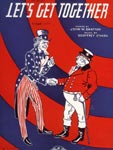 John
W. Bratton and Geoffrey O'Hara. John
W. Bratton and Geoffrey O'Hara.
"Let's Get Together." Cleveland: Sam Fox Publishing Company, 1941.
Sheet music cover.
Music Division,
Library of Congress (85c)
|
|
|
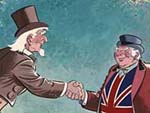 John
R. Fischetti. John
R. Fischetti.
"Time for a New Declaration,"
1953.
Color drawing.
Prints and Photographs
Division, Library of Congress (296)
|
Declaration of Interdependence
This 1953 cartoon accompanied an editorial
in Collier's magazine in response to an eruption of anti-British
feeling in the U.S. after disparaging remarks by former
Prime Minister Clement Atlee. The editorial reminds Americans
of the important ties between the two countries and suggests
that they draw up a"Declaration of Interdependence" instead
of criticizing each other.
|
|
Cold War Tensions
This cartoon from the British humor
magazine Punch reflects Cold War tensions and the strains
that sometimes have developed in the"special relationship" between
the United States and Britain. Uncle Sam is depicted
as a householder who won't cooperate with the British
as represented by John Bull, but does not want the British
to turn to the Soviet Union. |
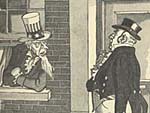 "And
don't let me catch you trying next door either." "And
don't let me catch you trying next door either."
Punch, April 29, 1959, p. 569.
General Collections, Library
of Congress (295)
|
|
Online
Survey - Exhibitions
Home - Library of Congress
Home
 Library
of Congress Library
of Congress
Contact Us
(
December 30, 2005
)
|

 As
personifications of their respective nations, Uncle Sam and John Bull
became popular during the nineteenth century. John Bull originated
earlier, as a character in John Arbuthnot's The History of John
Bull (1712). He became widely known from cartoons by Sir John
Tenniel published in the British humor magazine Punch during
the middle and late nineteenth century. In those cartoons, he was portrayed
as an honest, solid, farmer figure, often in a Union Jack waistcoat,
and accompanied by a bulldog. He became so familiar that his name frequently
appeared in books, plays, periodical titles, and as a brand name or
trademark. Although frequently used through World War II, since the
1950s John Bull has been seen less often.
As
personifications of their respective nations, Uncle Sam and John Bull
became popular during the nineteenth century. John Bull originated
earlier, as a character in John Arbuthnot's The History of John
Bull (1712). He became widely known from cartoons by Sir John
Tenniel published in the British humor magazine Punch during
the middle and late nineteenth century. In those cartoons, he was portrayed
as an honest, solid, farmer figure, often in a Union Jack waistcoat,
and accompanied by a bulldog. He became so familiar that his name frequently
appeared in books, plays, periodical titles, and as a brand name or
trademark. Although frequently used through World War II, since the
1950s John Bull has been seen less often.





